“The first word that springs to mind when I think of Inishturk is ‘connections’... Whether you’re family or not, islanders shake your hands and get to know you."
It’s mid-August, and I’m standing on a ferry deck, clinging to an iron railing for dear life. The 50-minute route is between County Mayo’s Roonagh Quay and the sparsely populated Inishturk — an island with a history spanning 6,000 years.
One of my fellow passengers says something to me, but I’m too consumed by the sudden swell of waves throwing the vessel around the Atlantic Ocean like a rag doll. Inspired by Croagh Patrick, the popular pilgrimage site on the horizon, I attempt to emulate Moses — the biblical figure who was a deft hand at manipulating vast bodies of water. Despite my best efforts at visualizing calmer conditions — choppy waters and giddy stomachs persist.
“Don’t worry,” the same passenger says, bemused by my petrified state, “it’s not often like this, but still perfectly safe!”
And he should know. Originally from County Tyrone, Michael Colton, as he introduces himself, has sailed this crossing several times since falling in love with local woman, Trish — now his wife. Eager to keep distracted, I quiz him about his impressions of Inishturk, which translates from Gaelic as the ‘Island of the Wild Boar’. His face immediately shines like today’s sun, now playing hide and seek with the clouds overhead.
“The first word that springs to mind when I think of Inishturk is ‘connections’,” he praises, referencing the island’s community spirit. “Whether you’re family or not, islanders shake your hands and get to know you. My father-in-law, Paddy O’Toole, tends to his garden regularly as it allows him to chat to other locals or tourists exploring the island.”
As we pass the uninhabited Caher Island — the site of a former Christian monastery — Michael reveals his reason for traveling to Inishturk today is to be reunited with his wife and children, who have spent the summer there. During the pandemic, they were all able to relocate to the island — a silver lining amidst the chaos hijacking the world.
“We previously considered bringing our family up on Inishturk full time, but the logistics proved too difficult,” he says, referring to the fact that teenagers must uproot to the mainland for their education, returning only at weekends. There is a primary school on Inishturk for the younger children — currently, there are just three pupils on the roll call, making it the smallest school in the country.
Another passenger joins our conversation, Aoife, who hails from the nearby Clare Island. Like Michael, she married a local — Eugene O’Toole.
“There’s something unique about Inishturk,” she praises, her love of the island evident in her every word — adding that her in-laws regularly welcome dozens of family members returning to the island from around the world. “When we arrive in a few minutes, you’ll know why people want to spend so much time there.”
No sooner has Aoife uttered these words than the ferry is being secured to the pier
— a sight I never thought possible earlier in the crossing — and I immediately witness what my two new friends are describing. Awaiting us are at least a dozen islanders, arms spread wide, ready to greet the new arrivals. Any remnants of seasickness evaporate into the afternoon sky.
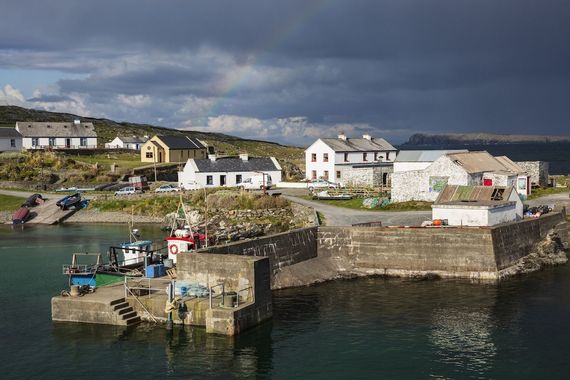
Inisturk Harbour, County Mayo.
Community spirit
Mary Catherine Heanue, my delightful host during my stay, leads me away from the pier — passing tea rooms, St Columba’s church and a recently completed playground, complete with an impressive zip-line. Moments later, we arrive at her beautiful guesthouse, Ocean View — perfectly named given the sweeping coastal views it commands.
While chatting, it emerges that her grandsons are the ferry’s skippers, and I’ve them to thank for successfully navigating the dramatic conditions and ensuring my safe arrival. Mary Catherine explains that since the ferry’s launch in 1997, tourism has soared — particularly amongst those wanting to “get away from it all and enjoy the views and scenery.”
“Inishturk is also very popular with swimmers, anglers and walkers. The island is on many people’s bucket lists.”

Are you planning a vacation in Ireland? Looking for advice or want to share some great memories? Join our Irish travel Facebook group.
Amongst the many family photographs lining the walls of her home, I notice a quirky sign that reads: ‘Here lives a fisherman with the catch of his life.’ Mary Catherine, originally from the nearby Inisbofin, explains that in 1973, her fisherman husband, Bill, was playing football on her island — and while his intentions may have been to win the match, he ended up winning her heart. They later married, rearing their six children here. Today, two of them — Eamon and Brid — remain, along with an additional fifty islanders.
“Inishturk has come a long way in recent years, with new houses being built or old ones being renovated,” she says. “And with more and more people working remotely, there are many reasons for people to stay here longer — or to come back for good. There are even two German families on the island now. We are very welcoming.”
Mary Catherine, who travels to the mainland weekly, describes the many activities and events taking place on the island throughout the year. The long list includes a football camp, regatta, circus and ram fair and sheep show — along with a selection of classes covering a range of topics from First Aid to computer skills.
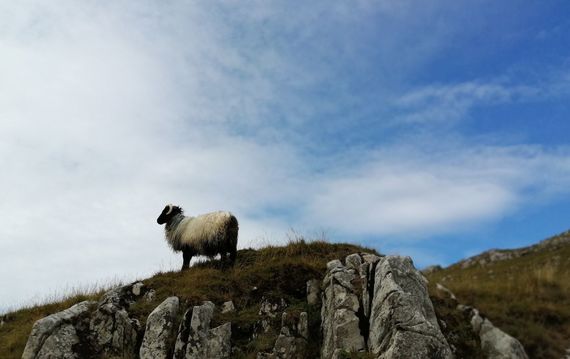
A ram perched on a cliff on Inisturk.
Walking loops
Before exploring the area, I press Mary Catherine to name her favorite spot on the island, which encompasses just 6 square kilometers. Immediately, she cites the tiny harbor of Portdoon — which is, I soon discover, protected from the sea by rocks and boasts a lagoon with traditional currach boats bobbing on the calm surface. The ghosts of a ninth-century Viking stronghold overlook the harbor. Given its serenity today, it’s hard to reconcile the drama that once unfolded here — all in the name of alcohol!
Legend suggests Danish pirates could brew heather beer. When the Irish recaptured the fort, they saved an elderly man and his son — but in exchange for their freedom, they wanted their brewing recipe. Determined to protect his secrets, the elderly pirate opted instead for death, plunging into the ocean — and depriving the Irish of the coveted process!
Portdoon Harbour is just one of the many attractions along the two walking loops of the island. I pass a Napoleonic signal tower, beehive huts, ancient burial sites and the remnants of open-air cooking sites — Fulachta Fiadh — dating from the Bronze Age. The football pitch, etched into the landscape, is often cited as the most beautiful in Ireland. Today, it’s currently bestrewn with glamping yurts — and I’m told it’s the perfect setting for stargazing, another popular activity on the island.
The best is yet to come. Toward the north of the island stand Inishturk’s famed cliffs and sea stacks, devastating in their composition and beauty. Rams and sheep, impervious to the steep decline, happily graze on the surrounding grass while gulls, puffins, guillemots, kittiwakes, gannets and peregrine falcons soar above the waves crashing against the jagged landscape. These views are why many describe the Wild Atlantic Way as the world’s most magnificent coastal route.
Another distinctive feature here is an installation named Tales of the Tongs, created in 2013 as part of The Gathering — a tourism-led initiative to encourage the Irish diaspora to return home.
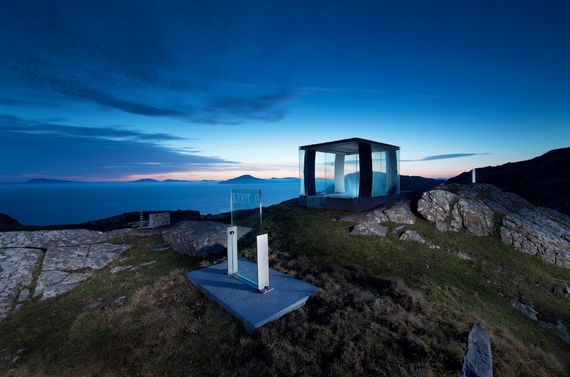
Tales of the Tongs installation on Inisturk.
The eye-catching installation commemorates those who have lived on — and emigrated from — the island. The title refers to the custom where a person would gift coal and tongs to loved ones leaving for America or England. This exchange became a promise that the emigrants would return to Irish shores one day — bringing with them coal and tongs to rekindle their connection with the island.
An ambitious collaboration between the Catholic University of America's School of Architecture and Planning, led by architect Travis Price, and Mayo County Council, the project deftly incorporates local stone with glass and stainless steel using modern and traditional building methods. Locals have since christened it the Acropolis of Ireland!
The reel deal
One of these entertaining locals, Jack Heanue, brings me on a fishing expedition that evening — a highlight of my visit. Jack, the 73-year-old brother of Mary Catherine’s husband, Bill, proudly describes islanders as “self-sufficient” and credits his longevity and good health on “sea air and hard work”.
“Living on an island means you’ve always to do that bit more,” he says as we venture out on the turquoise — and noticeably calmer — waters, passing some of the island’s unspoilt beaches along the way. Jack briefly worked in England but soon returned to Inishturk as “fishing and island life are in my blood — my D.N.A.”
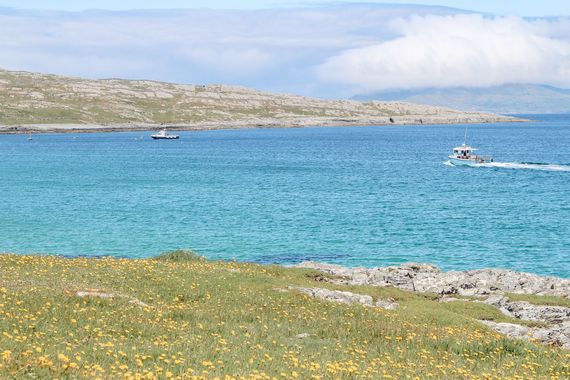
Fishing boats of Inisturk.
While Jack’s usual catch are lobsters, crab and crayfish, today, our interest is in pollock, mackerel and cod. As the fishing rods are put to good use, Jack jokes that his wife, Helen, a former nurse, once suggested he retire — an idea he immediately shot down by posing the question: “What else would I do?”
The couple has three sons spread out across England and Australia — one is currently spending the summer on Inishturk.
“For the island to survive, families must want to live here and rear their families,” he says, adding that almost half of the islanders would be classed as senior citizens, with two men in their late 80s. Like others, he references the pandemic and people’s ability to work from home as an opportunity for people to relocate here.
A room with a view
Someone who has made Inishturk their new home — for the meantime, at least, is Síle Ní Oistín Feeney, originally from Spiddal in the Connemara Gaeltacht. When her husband secured employment on the ferries here, she gladly joined him and is currently a staff member in Caher View restaurant, located in the island’s community center, opened by former president Mary Robinson in 1993.
Claiming some of the most magnificent views I’ve ever seen, the property, which also serves as a bar, library, shop and social outlet, is an essential facility for islanders and tourists alike.
“It’s a fantastic place to dine or have a drink,” Síle tells me as Gaeilge, adding that locals immediately welcomed her on arrival.
While those Danish pirates might have been reluctant to share recipes, Síle isn’t — explaining that my seafood pie is bursting with locally caught crab and other fish. Their head chef, Zaheed Manjoo, hails from Mauritius but specializes in traditional Irish food — with a twist. As I boast about my earlier fishing success, I notice two young musicians enter the center, guitars in hand.
“We have musicians regularly playing here,” Síle explains. “We’ll clear the tables, and people will dance the night away.”
As punters stream into the center, full of excitement, I suspect the merriment will continue into the wee hours. Thankfully, the fish I’m devouring is packed with goodness, as it looks like I’ll need my energy on the dancefloor later.
O’Malley’s Ferries operates a daily service from Roonagh Pier, near Louisburgh, to Inishturk.
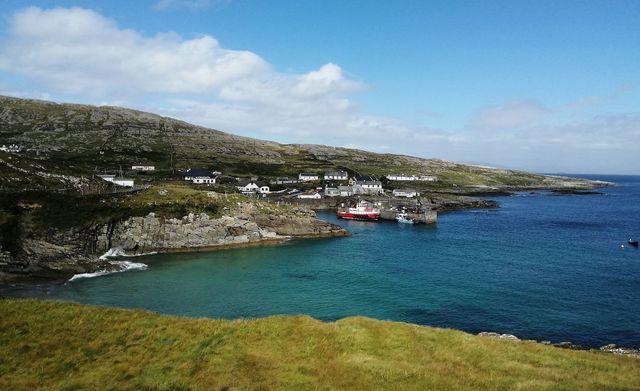


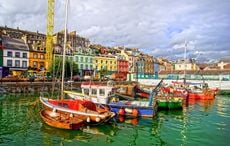
Comments